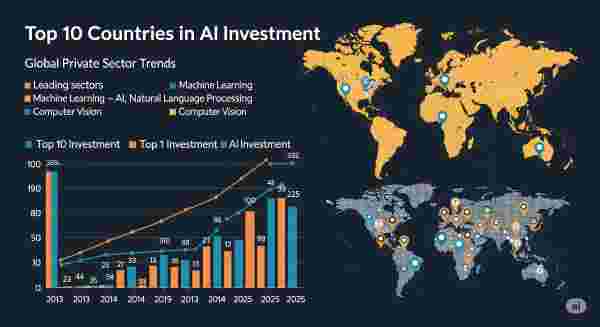Top 10 Countries in AI Investment: Global Private Sector Trends (2013–2025)

Top 10 Countries in AI Investment: Global Private Sector Trends (2013–2025)
The global race for leadership in Artificial Intelligence (AI) has seen major investments from both governments and private enterprises. This summary focuses on private sector AI investments from 2013 to 2024, including projections for 2025, highlighting the top 10 countries making the biggest financial commitments.
-
United States The U.S. dominates in private AI investment, thanks to a thriving tech ecosystem, venture capital networks, and innovation hubs like Silicon Valley. Major companies including Google, Microsoft, and OpenAI drive substantial funding and research.
-
China China ranks second, with strong state-aligned private investment strategies. Its focus includes AI in manufacturing, surveillance, and consumer applications, backed by major tech firms like Baidu, Tencent, and Alibaba.
3–10: Other Leading Nations Each of the following countries also plays a key role in the evolving global AI ecosystem:
- United Kingdom – Strong in ethical AI, academia, and fintech applications.
- Canada – Known for foundational AI research, including deep learning innovations.
- Israel – Emphasizes AI in cybersecurity, defense, and medical technologies.
- Germany – Leads in industrial AI, automation, and precision manufacturing.
- India – Rapidly growing in AI development, especially in service sectors and startups.
- France – Active in AI policy, research collaboration, and language-based models.
- South Korea – Excels in robotics, consumer electronics, and smart infrastructure.
- Singapore – A hub for AI governance, urban planning, and financial innovation.
These rankings are based primarily on private market investments and do not fully capture government R&D or public sector spending. However, they reflect the dynamism and strategic focus of national AI ecosystems across the globe.
As AI continues to evolve, the investment landscape remains highly dynamic, with emerging markets, policy shifts, and technological breakthroughs reshaping global leadership patterns.


